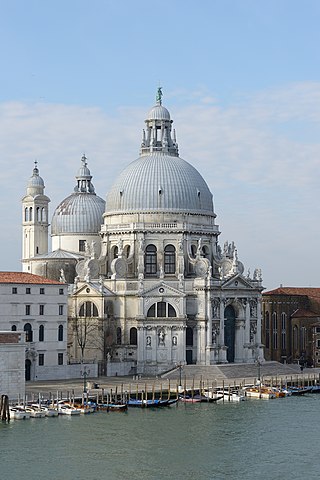
Venice is a city in northeastern Italy and the capital of the Veneto region. It is built on a group of 127 islands that are separated by expanses of open water and by canals; portions of the city are linked by 472 bridges. The islands are in the shallow Venetian Lagoon, an enclosed bay lying between the mouths of the Po and the Piave rivers. In 2020, around 258,685 people resided in greater Venice or the Comune di Venezia, of whom around 51,000 live in the historical island city of Venice and the rest on the mainland (terraferma). Together with the cities of Padua and Treviso, Venice is included in the Padua-Treviso-Venice Metropolitan Area (PATREVE), which is considered a statistical metropolitan area, with a total population of 2.6 million.

The Lido, or Venice Lido, is an 11-kilometre-long (7-mile) barrier island in the Venetian Lagoon, Northern Italy; it is home to about 20,400 residents. The Venice Film Festival takes place at the Lido in late August/early September.

Santa Maria della Salute, commonly known simply as La Salute, is a Roman Catholic church and minor basilica located at the Punta della Dogana in the Dorsoduro sestiere of the city of Venice, Italy.

A lazaretto, sometimes lazaret or lazarette, is a quarantine station for maritime travelers. Lazarets can be ships permanently at anchor, isolated islands, or mainland buildings. In some lazarets, postal items were also disinfected, usually by fumigation. This practice was still being done as late as 1936, albeit in rare cases.

Sant'Elena is an island of Venice. It lies at the eastern tip of the main island group and forms part of the sestiere of Castello. The original island was separated by an arm of the Venetian Lagoon from Venice itself and was centered on the Church of Sant'Elena and its monastery, originally built in the twelfth century and rebuilt in the 15th.

Cologno al Serio is a comune (municipality) in the Province of Bergamo in the Italian region of Lombardy, located about 45 kilometres (28 mi) northeast of Milan and about 10 kilometres (6 mi) south of Bergamo.
A lazareto is a quarantine station for maritime travelers.

The Trans-Allegheny Lunatic Asylum was a psychiatric hospital located in Weston, West Virginia and known by other names such as West Virginia Hospital for the Insane and Weston State Hospital. The asylum was open to patients from October 1864 until May 1994. After its closure, patients were transitioned to the new William R. Sharpe, Jr. Hospital in Weston, named after William R. Sharpe Jr., a member of the West Virginia Senate. The hospital reopened as a tourist location in March 2008.

Angelo Antonio Frari was a Dalmatian Italian physician, who served as the municipal physician and the head of the lazaretto of Split, province of Spalato (1806–1821), the protomedicus, and the president of the Maritime Health Magistrate of Venice (1835–1843), famous epidemiologist and historian of medicine.

Ghost Adventures is an American paranormal and reality television series that premiered on October 17, 2008, on the Travel Channel before moving to Discovery+ in 2021. An independent film of the same name originally aired on the Sci-Fi Channel on July 25, 2007. The program follows ghost hunters Zak Bagans, Aaron Goodwin, Billy Tolley, and Jay Wasley as they investigate locations that are reported to be haunted.

The Lazzaretto Vecchio, formerly known as Santa Maria di Nazareth, is an island of the Venetian Lagoon, northern Italy, located near the Lido of Venice. Between 1403 and 1630 it housed a hospital which cared for people during the plague epidemics and as a leper colony, giving rise to the English words lazaret and lazaretto. It was later used, as were other islands, as a military post. It covers an area 2.53 hectares large.

Malamocco was the first, and for a long time, the only, settlement on the Lido of Venice barrier island of the Lagoon of Venice. It is located just south of the island's center and it is part of the Lido-Pellestrina borough of the municipality of Venice.

Sacca Sessola, also called Isola delle Rose or "Island of Roses", is an island in the Venetian Lagoon, Veneto, Italy. The island's name is derived from combination of the words sacca, Venetian for an artificial island, and sessola, a tool used to remove water from ships.
Isola di San Clemente is a small island in the Venetian Lagoon in Italy. For centuries it housed a monastic settlement, and more recently an asylum. It is now the site of a luxury hotel.
Ghost Asylum is an American paranormal television series that aired from September 7, 2014, to June 5, 2016, on Destination America. The series features a group of professional ghost hunters that try to "trap ghosts" in the country's most haunted abandoned asylums, sanitoriums, and mental hospitals. The show was renewed for a second season of 15 episodes, which premiered on April 5, 2015, and aired in two halves with the second half airing in late-2014.
The following is a timeline of the history of the city of Venice, Veneto, Italy.

Lido Fanale Anteriore Lighthouse is an active lighthouse located on the northern tip of the island of Lido di Venezia, in the Venetian Lagoon on the Adriatic Sea; the place where is the main access to Venice by ship route.















